Last season, Julien Stéphan guided Strasbourg to their best Ligue 1 finish since 1980, as they ended 2021/22 in sixth place on the table — a nine-place jump from 2020/21 under Thierry Laurey. This was, of course, an excellent start to life at Stade de la Meinau for the 42-year-old manager.
However, this season has been far less positive for Le Racing, with the club sitting in 14th place after 10 league games, level on eight points with 17th-placed Angers — currently occupying a relegation spot. Strasbourg were the last team in France’s top flight to get a win in 2022/23, with Stéphan’s men only managing to win their first game of the season last weekend in a 3-2 victory over Angers.
So, why have Strasbourg been struggling so much more this term than they did last term, when all seemed rosy for the Alsace-based club under the leadership of promising coach Stéphan? This tactical analysis and scout report provide an analysis of some factors we’ve identified as being important contributors to Strasbourg’s struggles this season while we analyse their individual performances, strategy and tactics to determine what’s going wrong this term.
Less defending from the front in 2022/23
Strasbourg ended last season with the fourth-highest expected goal difference (+13.6) in France’s top flight when they finished in sixth place in the league. Meanwhile, at present, they’ve got the fifth-lowest expected goal difference in the league (-3.0) while they’ve got the joint-fourth lowest points total.
They’re currently scoring just 0.92 goals per game which is a significant drop off from 1.48 goals per game last season, but their xG per shot is actually better than last season (0.137 xG per shot this season to 0.133 xG per shot last season).
Stéphan’s side are also conceding more goals this season (1.29 per game) than they did last term (1.06 per game). Their xG per shot against has also jumped to 0.141 this season from just 0.119 last season — a significant increase.
Along with that, Strasbourg have actually been conceding more shots too — 10.7 per 90 this term compared with 9.21 per 90 last term.
From this, we can see that Strasbourg have been performing worse at both ends of the pitch this season than last season but while results have notably dropped in front of goal, their performance levels — at least in terms of the quality of shot they’ve generated — has been similar. However, the quality of shots they’re conceding has become a greater cause for concern than perhaps it had been last season.
There are plenty of contributing factors to this, without a doubt, but one major one in our view is the fact that Strasbourg have been defending from the front far less in 2022/23 than they did in 2021/22.
In a scout report here at Total Football Analysis from last December looking at: “Why ‘on fire’ Strasbourg are Ligue 1’s second-highest scoring side” we touched on their aggression in defending from the front and even mentioned that they could, perhaps, be creating even more goalscoring opportunities from their pressing, given their aggressive nature.
Per Statsbomb via FBRef, Le Racing ended last season with the fourth-most pressures in the attacking third of any team in France’s top-flight but this season, they’ve made the fifth-fewest pressures in the attacking third of any Ligue 1 side. Per Wyscout, their PPDA has increased from 11.13 last season to 12.52 this season as well.
Part of the reason for this comes down to Ludovic Ajorque playing far fewer minutes this term, with Habib Diallo starting more frequently. We recommended Diallo in a recruitment analysis piece as a great option for Lille in the summer before they signed Mohamed Bayo — we rate the forward highly.
In particular, Diallo is an excellent option for Stéphan and his tactics in possession. He’s exactly the kind of forward who thrives in Strasbourg’s offensive system (which you can read more about in detail in the aforementioned piece discussing the 42-year-old coach’s approach at Stade de la Meinau from last December). However, Diallo offers far, far less without the ball than Ajorque, which is a significant drawback of his game that must be compensated for by his teammates.
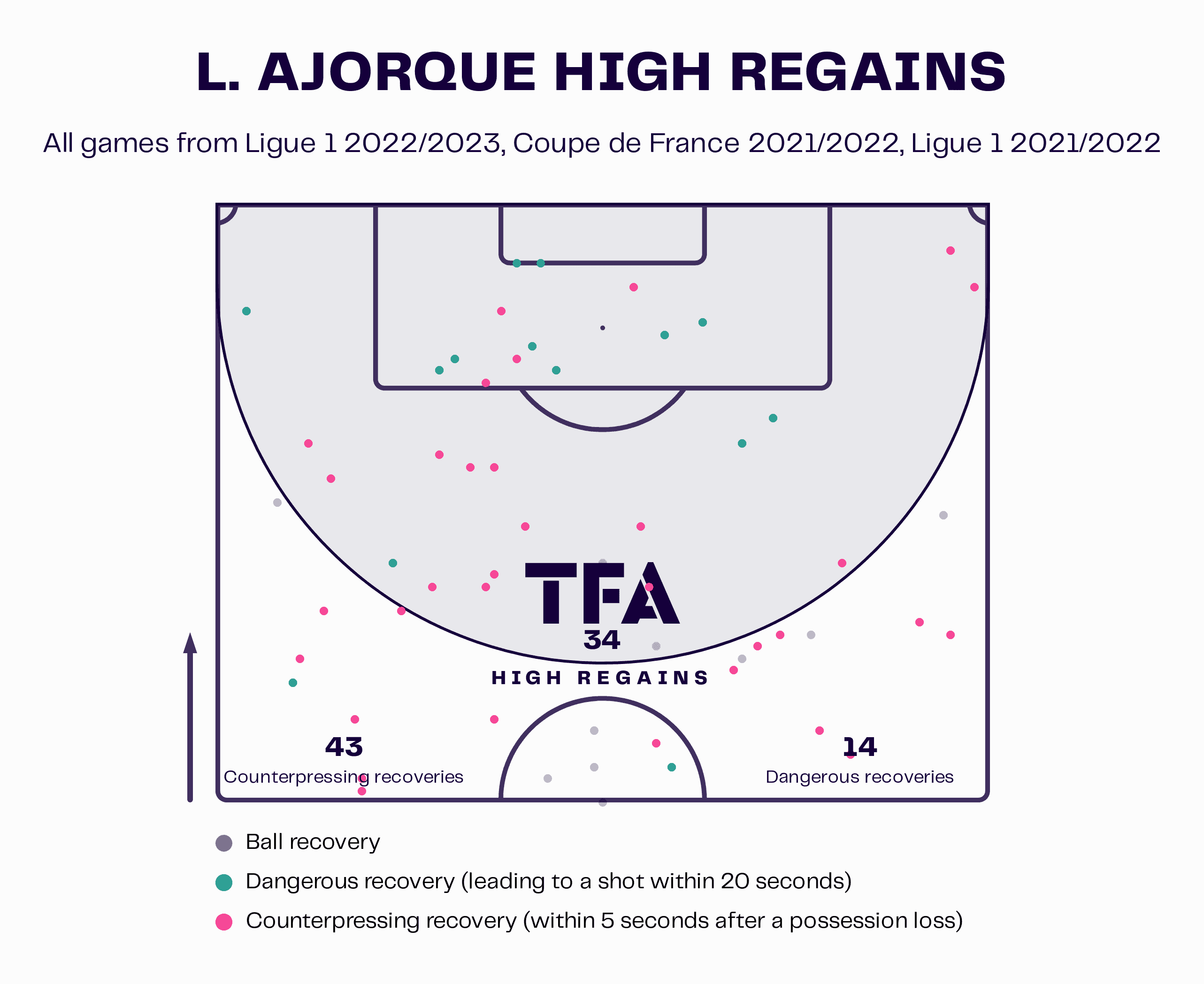
While Ajorque presses aggressively from the front and contributes a lot not only to his team’s defensive efforts but also their offensive efforts by creating plenty of goalscoring opportunities via his defending from the front, as figure 1 depicts, Diallo contributes far less in that regard, as figure 2 depicts, even counting for the fact that Ajorque has enjoyed slightly a few hundred more minutes of game time over this season and last than Diallo, in total, in that same time.
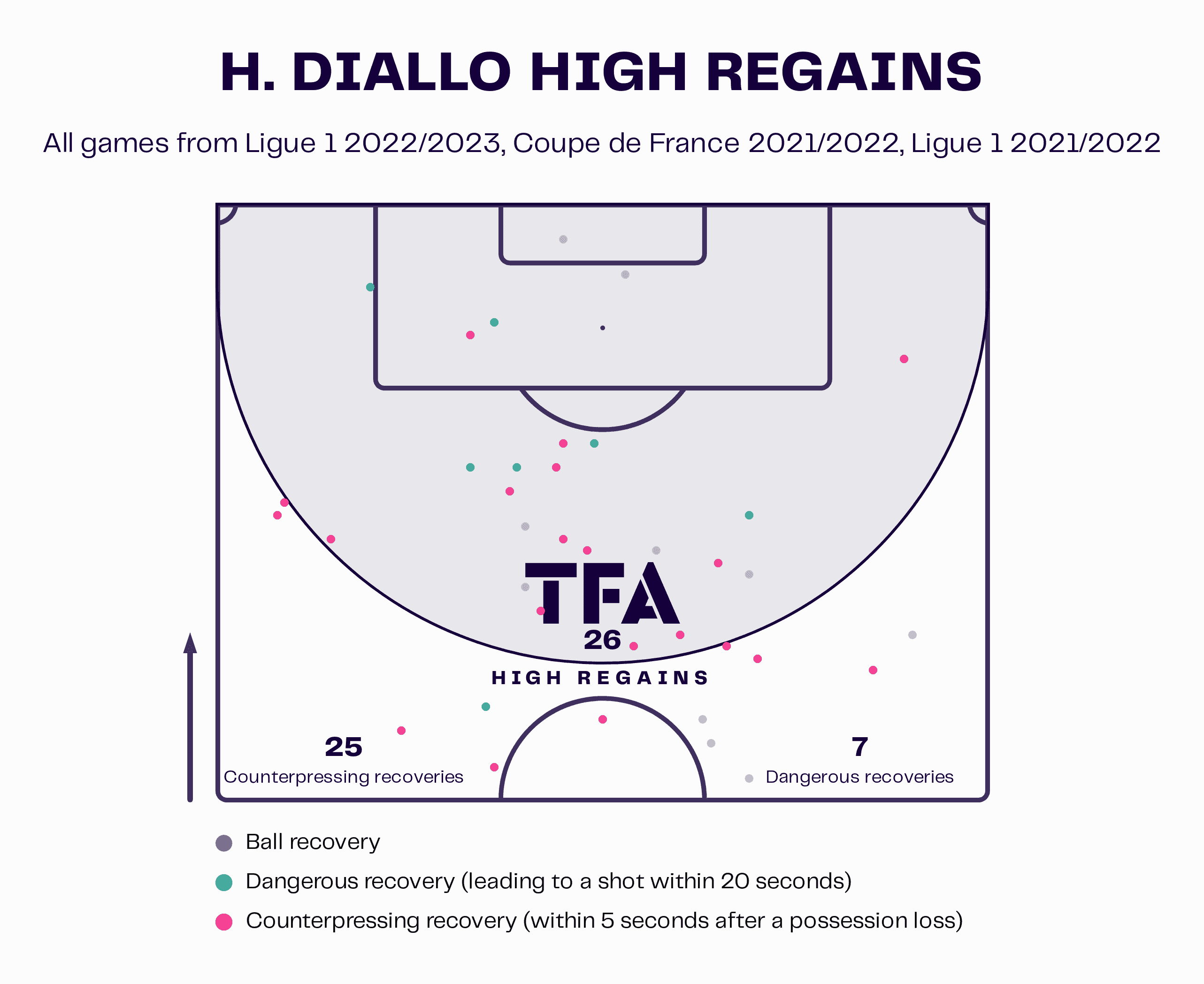
The per 90 numbers back up our claims, with Ajorque making 4.56 successful pressures per 90, per Statsbomb via FBRef, than Diallo who makes 3.46 successful pressures per 90; Ajorque makes 1.29 tackles per 90 to Diallo’s 0.47.
All of this has a significant impact on Strasbourg’s defending and has, undoubtedly, contributed to Le Racing’s poorer performance when defending from the front this season, with Ajorque missing recent games due to injury and not starting this campaign as he finished the previous one in any event, following a summer full of transfer speculation with Strasbourg said to have been keen to cash in on the valuable forward amid alleged interest from EPL suitors including Everton, Wolves, West Ham United, Crystal Palace and more in the rumour mill.
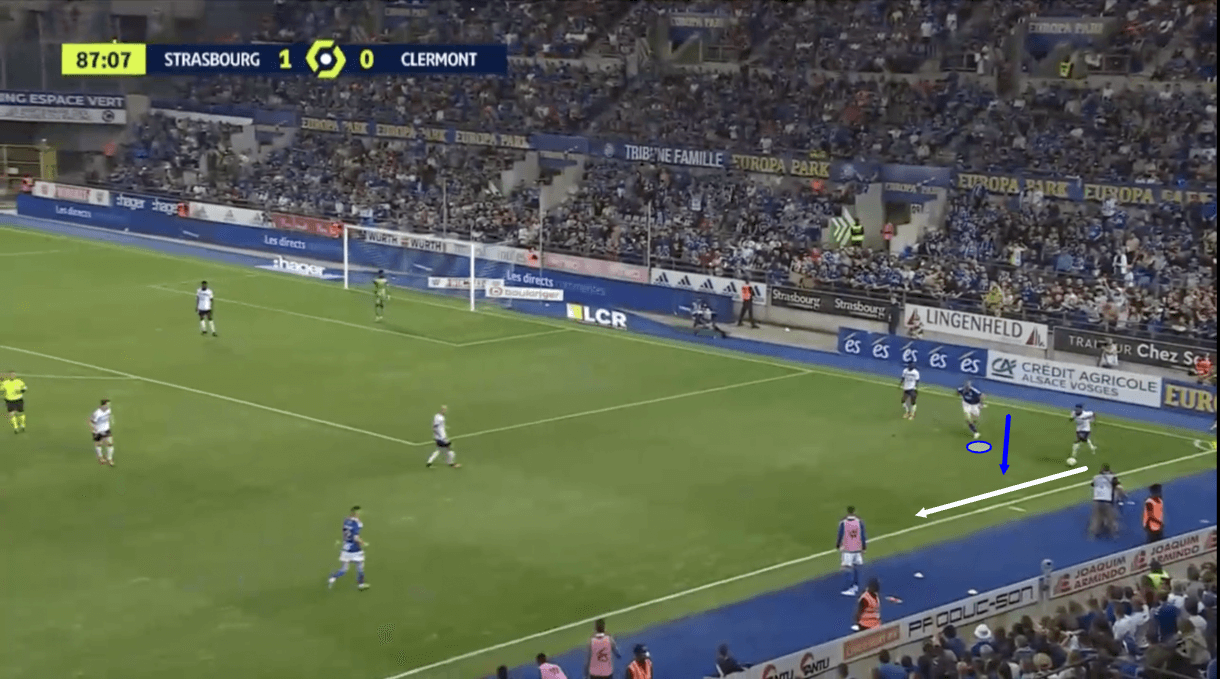
Figures 3-4 show an example of Ajorque’s excellent attitude without the ball from 2021/22. Just before this image, the 197cm striker was on his backside at the byline having been dispossessed but after a foul was not immediately called, he quickly returned to his feet like a man on a mission to reclaim possession from the one that dispossessed him.
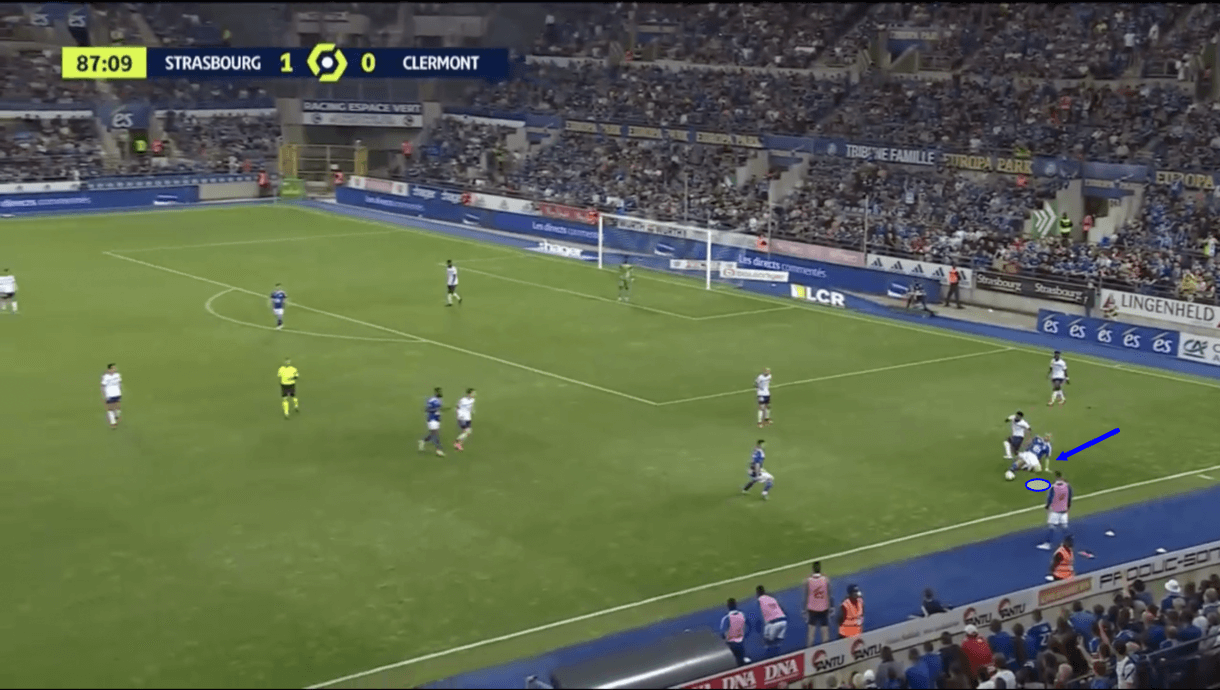
The large forward charged back and slid in on the man who dispossessed him, ending the opposition’s ball progression and allowing his side a chance to regroup.
This is just one example of Ajorque’s defensive work rate and positive attitude but this was evident throughout last campaign when watching Strasbourg — Ajorque’s ability to defend from the front clearly added something extra to Le Racing’s defensive game and made it so much more difficult for the opposition to play through them and generate chances, simply because they had far less time on the ball. The high regains also, in turn, allowed Strasbourg to attack a vulnerable opposition defence from dangerous positions.
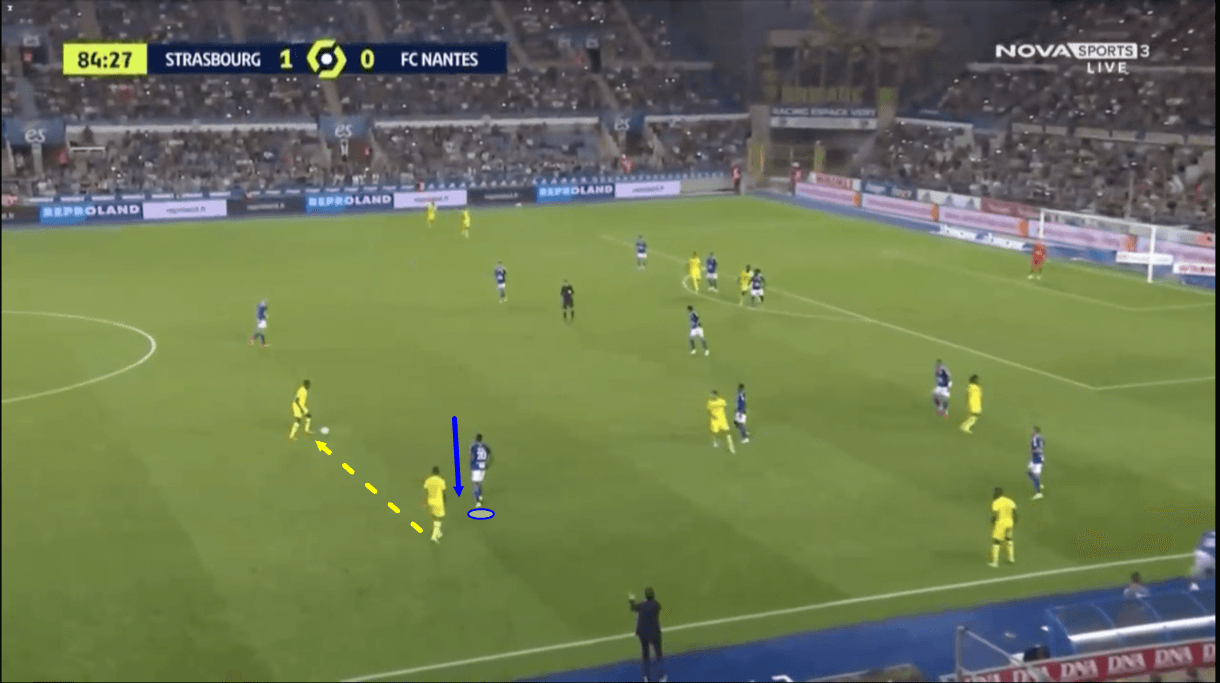
Meanwhile, figures 5-6, from this season, highlight an example of 185cm Diallo perhaps not offering enough out of possession, allowing the opposition too much time on the ball to pick out a good pass that puts the defence under pressure. Just before this image, the ball moved centrally for Nantes, in behind Diallo from where he had just pressed.
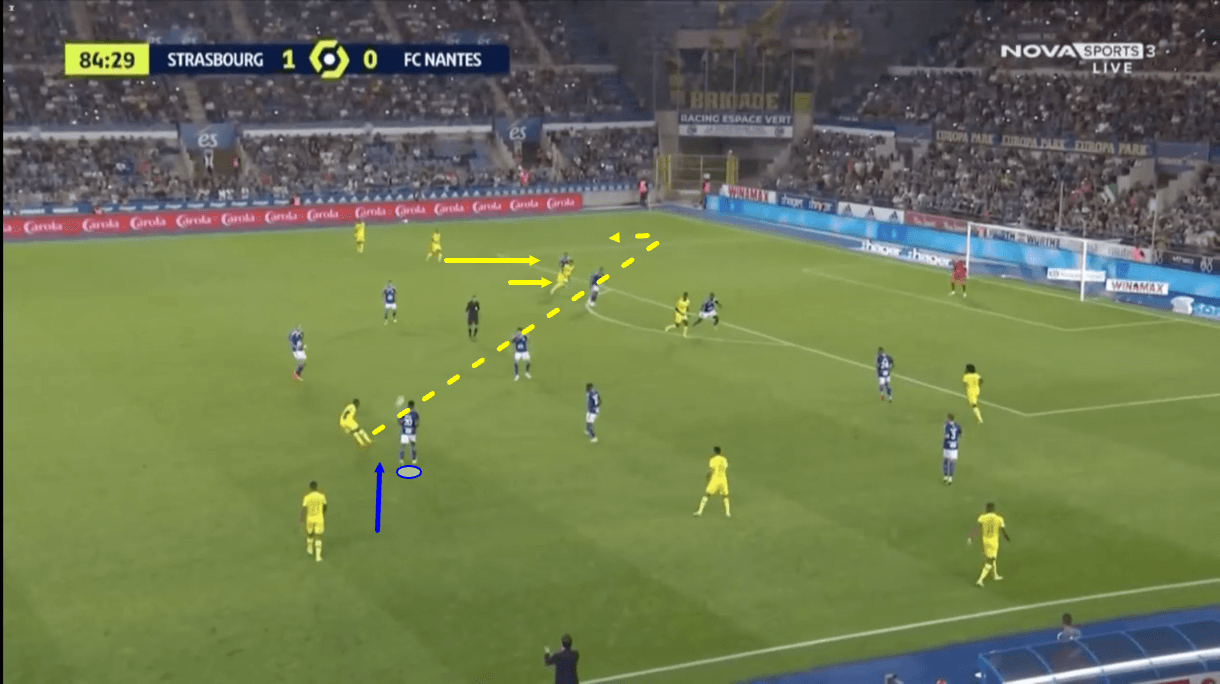
Despite Stéphan’s visible motioning for more pressure on the opposition ball carrier from the sideline, the passer enjoyed plenty of time to get his head up, set himself and curl a cross to towards the far side of the box where his team enjoyed an overload. From here, Nantes’ attackers got the ball down and under control, linked up with one another and set up a good goalscoring opportunity that they ultimately took, highlighting how devastating the lack of pressure and defensive support from the front can be.
These are just two examples to highlight the contrast between this season and last, of course, there are examples of Diallo pressing too but in general, he offers far less in that regard than Ajorque and for us, Strasbourg’s failure to apply as much pressure from the front this term has been a notable factor in their drop off this season.
Exploitation of Strasbourg’s aggressive backline
It’d be unfair to lay all of the blame for Strasbourg’s defensive frailties this term at the feet of their forwards, of course, so the next couple of sections will focus on a couple of different issues that have made life more difficult than perhaps has been necessary for their defenders.
We’re going to start with the exploitation of their aggressive centre-backs, which we’ll see two examples of in action in figure 7.
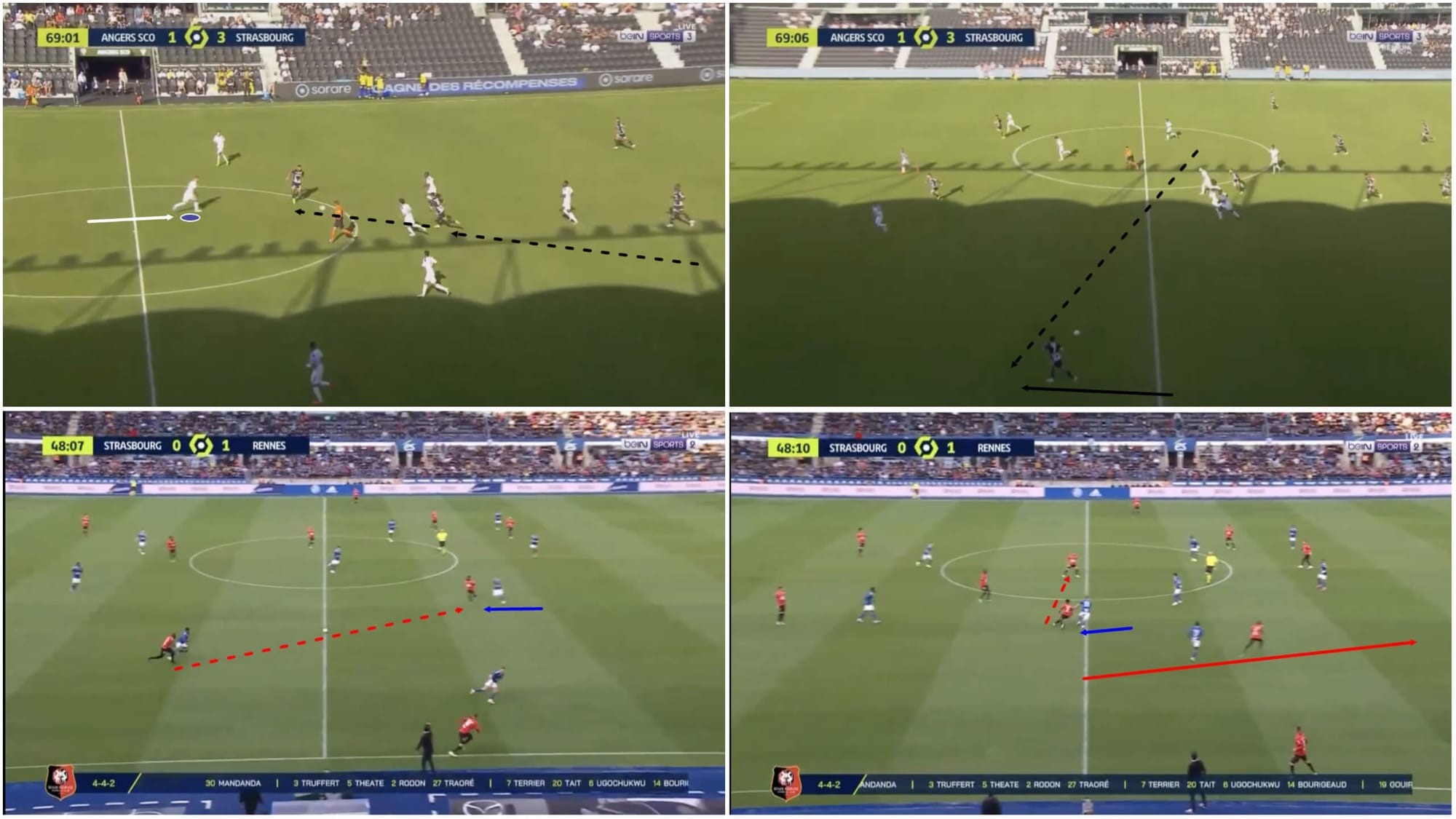
On top, we see an example of Strasbourg’s centre-back getting dragged out of position in transition, with the opposition ball carrier spreading play out to the wing as the centre-back steps out and his defensive partners close into the centre to cover for him. This pass out to the wing from the opposition finds a wide man in acres of space to drive forward into the final third and put Strasbourg’s weakened backline under pressure.
Meanwhile, on the bottom, we see an example of the opposition dragging a Strasbourg centre-back out following the build-up in a settled period of possession. The key that allowed them to drag this centre-back out was Strasbourg’s left-central midfielder, Jean-Ricner Bellegarde who offers tonnes to his side, particularly with the ball, stepping out to press the ball carrier (on Diallo’s side, on another occasion where perhaps the striker could’ve offered a bit more).
Bellegarde becomes isolated 1v1 and fails to prevent the opposition’s ball progression as the ball carrier finds a dropping forward without too much difficulty. This forward is then followed by the centre-back into midfield, opening a gap in the Strasbourg defence for the original ball carrier to go on and attack with a dangerous penetrating run. The option isn’t taken on this occasion, luckily for Le Racing, but it should be cause for concern for Strasbourg that they were opened up so easily here, as they have been on too many occasions this season.
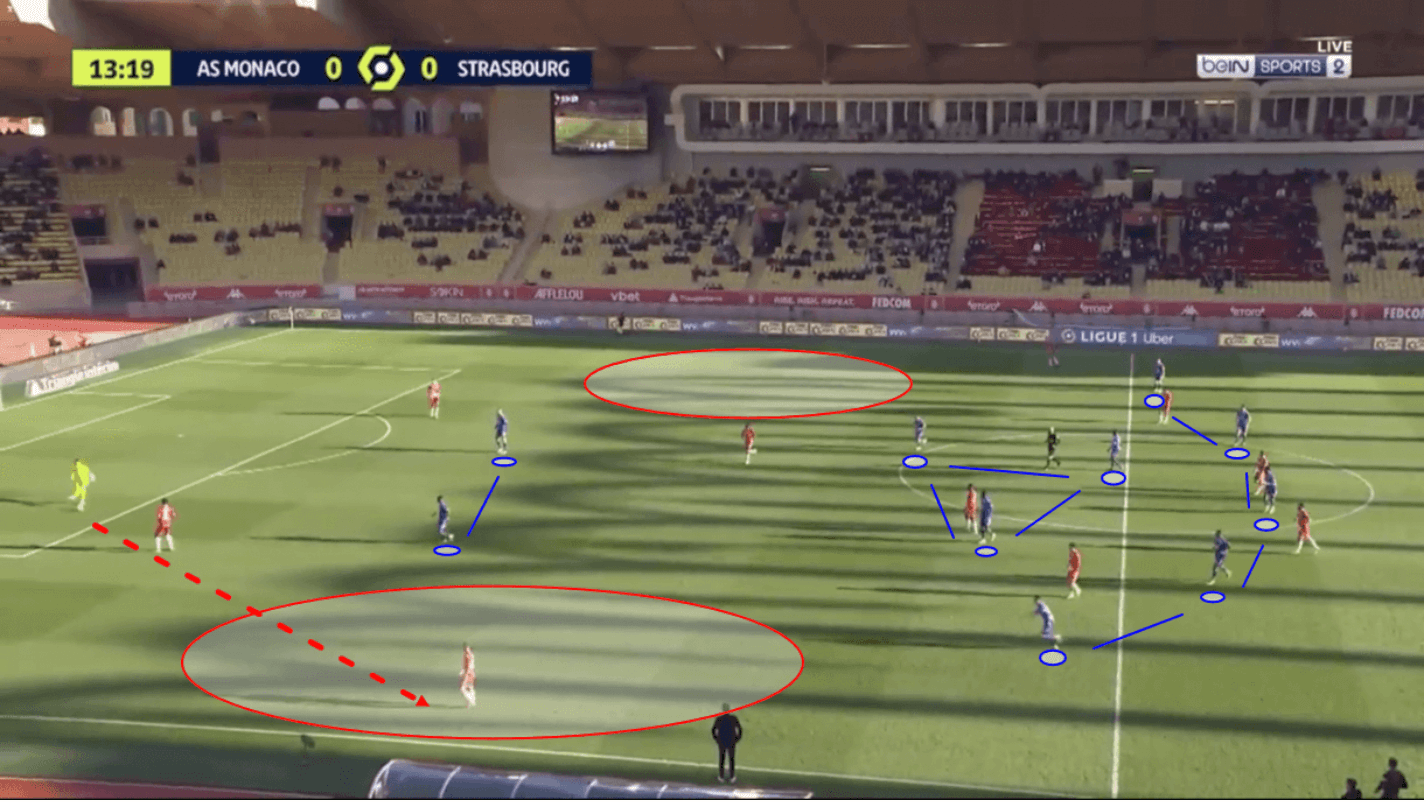
As figure 8 indicates, central compactness between the centre-backs and midfield was critical to the defensive success of this system last season. They can’t afford to lose their midfield trio with one pushing too high and breaking the connections between the players nor can they allow too much space to open up between the midfield line and defensive line. Both of these errors were made in the bottom example of figure 7.
It’s key for Stéphan’s system that the opposition is forced to progress via wide areas where the striker and/or wing-back can press them where they have less room to play with. In the examples from figure 7 this season, however, the opposition have managed to progress through Strasbourg’s shape centrally and forced the centre-backs to step high as a result, which can be exploited too easily, as we’ve seen.
So, it should be a priority for Strasbourg to get their defensive principles back in order and try to prevent their centre-backs from becoming so exposed so often in the future. If the team continues as they are, they’ll just keep affording their opponents too many easy opportunities to cut through them that could’ve been prevented if they got defensive basics right. Of course, it can be easier said than done, even when dealing with fundamentals but for us, there’s a clear difference between their performance in applying these principles from last season to this season.
Being their own worst enemy
For the final section of our analysis, we’re going to take a look at Strasbourg ‘being their own worst enemy’ so to speak, when it comes to their cheap ball losses when playing out from the back.
In general, Strasbourg have been just as if not even more effective with their build-up from the back and ball progression play than they were last season; they’ve played marginally more progressive passes with 69.34 this season to 69.17 last season and a slightly better progressive pass success rate (77.7% this term to 76.9% last term) along with slightly more long passes (49.98 per 90 to 47.3 per 90) and a better long pass success rate (62.2% to 58.7%) just to mention a few notable, promising statistics.
However, there have been plenty of occasions in which Strasbourg have given the ball away a little bit too cheaply when playing out from the back, resulting in a very dangerous counterattack for them to subsequently defend against, two of which can be seen in figure 9.
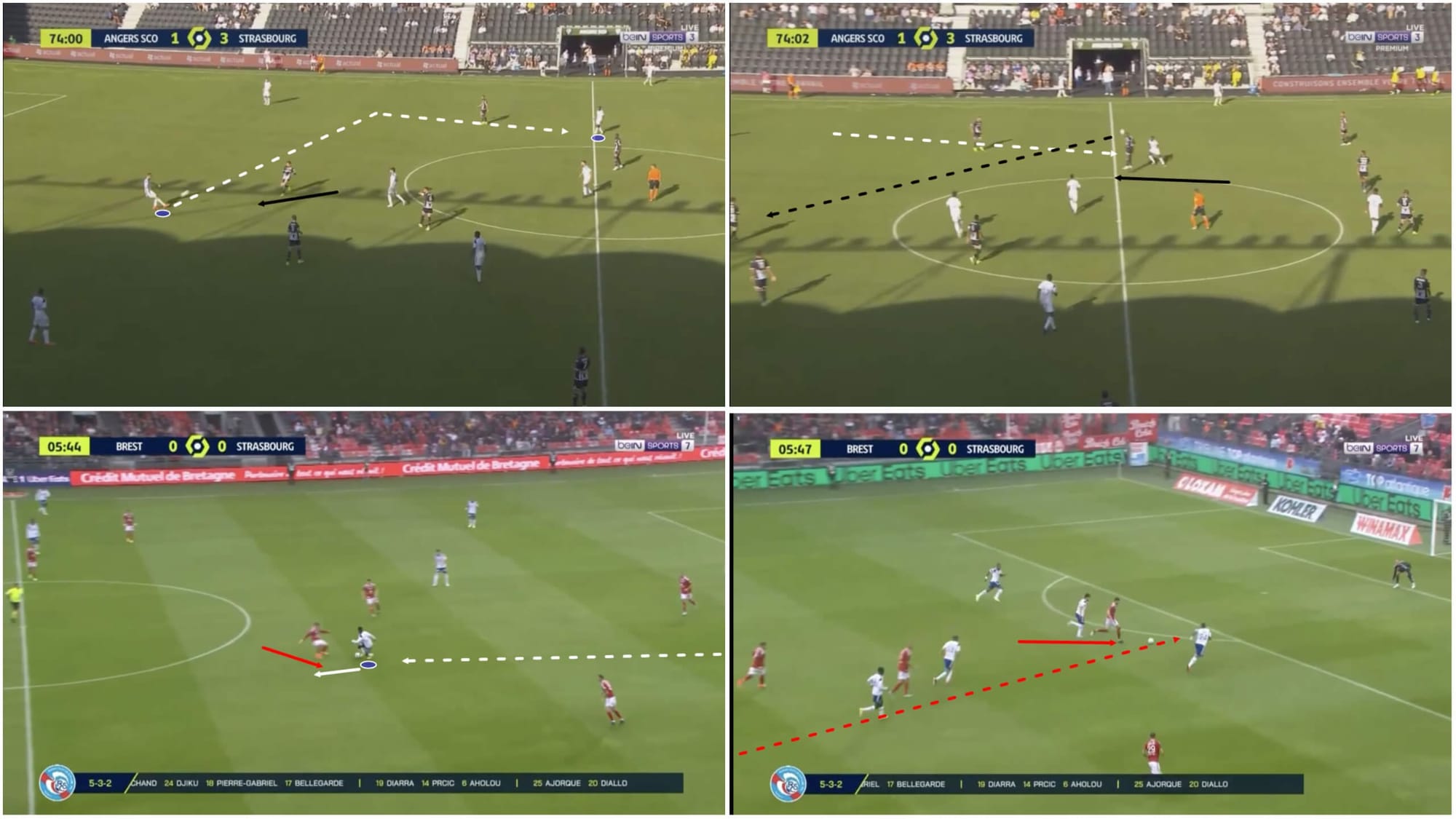
On the top of figure 9, we see Lucas Perrin attempting a dinked ball into midfield to left central midfielder Bellegarde. However, the pass is too light and basically creates an opportunity for an opposition midfielder to cut the pass out and regain possession for his team. From here, the midfielder can drive his team forward into the final third, where they can exploit Strasbourg’s weakened defensive line with three forwards, creating a very dangerous counter-attacking opportunity.
Meanwhile, the bottom of figure 9 shows an example of 18-year-old France U19 international midfielder Habib Diarra receiving the ball on the half-turn in midfield but not scanning effectively enough as when he turns, he runs straight into an opposition midfielder’s tackle, leading to his team getting dispossessed well inside their own half and the centre-backs quickly getting split open with an incisive through ball.
Both of these examples show an element of either carelessness or naivety in Strasbourg’s play in deep areas of the pitch, leading to unforced errors and unnecessary pressure on the backline. This is understandable to happen on occasion and it’s certainly normal for an 18-year-old to make a mistake like this, in Diarra’s case, but for Strasbourg, instances like this have occurred too often this season, allowing their opponents to create too many high-quality chances, some of which will inevitably be taken sooner or later; this is a big reason for the increase in their xG per shot against in 2022/23 compared to 2021/22 and their shots against count.
Conclusion
To conclude this tactical analysis and scout report, we feel the three areas explored in this article have all been significant contributors to Strasbourg’s defensive difficulties in 2022/23, which have been key factors in their worsened performance this term compared to last.
We don’t feel any of these factors are necessarily major fixes, just minor things that Stéphan’s side can amend to get their form closer to where it was last season before too long if the issues are addressed openly and honestly within the squad and they do the necessary work to improve their game.
For us, the issues largely aren’t tactical ones and we saw last season that Strasbourg’s system promises to deliver good results if implemented to the best of its ability, though that will require certain actions from the team. Stéphan has a good team at his disposal which they showed last season and they’re capable of delivering better results than they have so far this season, though there are clear issues that need solving in order to achieve those improved results.





Comments